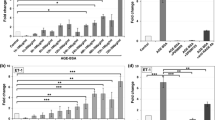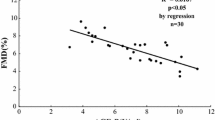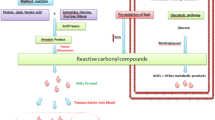Abstract
Objective
Advanced glycation end products (AGEs) and endothelial progenitor cells (EPCs) play divergent roles in the process of atherosclerosis. We investigated the effects of AGE-human serum albumin (AGE-HSA) on receptor expression for AGEs (RAGE) and EPCs apoptosis.
Methods
The human mononuclear cells were obtained by Ficoll density gradient centrifugation and cultured in M199 medium containing rh-VEGF (30 ng/ml), rh-b-FGF(6 ng/ml) and 20% NBCS for 8 days. The adhesive EPCs were sequentially harvested after 24 h synchronization and challenged with AGE-HSA (concentration range from 0 to 300 µg/ml) for 24 h and 200 µg/ml AGE-HSA (time range from 0 to 36 h). EPCs apoptosis and migration were determined, expressions of RAGE, phosphorylated ERK1/2, JNK and p38 mitogen-activated protein kinase (MAPK) of EPCs were quantified by fluorescent quantitation RT-PCR and Western-blot, effect of AGE-HSA on NF-κB activtiy was determined by EMSA (electrophoretic mobility shift assay) in the presence and absence of special MAPK pathways pathway inhibitors.
Results
AGE-HSA upregulated the expression of RAGE, this effect could be significantly inhibited by p38 MAPK and ERK MAPK inhibitor, but not by JNK MAPK inhibitor. AGE-HSA also promoted EPCs apoptosis and inhibited EPCs migration and increased NF-κB activity, these effects could be significantly attenuated by the anti-RAGE neutralizing antibody as well as by p38 and ERK MAPK inhibitors.
Conclusion
AGE-HSA could promote atherosclerosis by upregulating EPCs RAGE expressions and promoting EPCs apoptosis via p38, ERK MAPK pathways, activation of NF-κB might also play a role in this process.






Similar content being viewed by others
References
Asahara T, Murohara T, Sullivan A, Silver M, van der Zee R, Li T, Witzenbichler B, Schatteman G, Isner JM (1997) Isolation of putative progenitor endothelial cells for angiogenesis. Science 275:964–967
Boyer M, Townsend LE, Vogel LM, Falk J, Reitz-Vick D, Trevor KT, Villalba M, Bendick PJ, Glover JL (2000) Isolation of endothelial cells and their progenitor cells from human peripheral blood. J Vasc Surg 31:181–189
Chavakis E, Hain A, Vinci M, Carmona G, Bianchi ME, Vajkoczy P, Zeiher AM, Chavakis T, Dimmeler S (2007) High-mobility group box 1 activates integrin-dependent homing of endothelial progenitor cells. Circ Res 100:204–212
Cipollone F, Iezzi A, Fazia M, Zucchelli M, Pini B, Cuccurullo C, De Cesare D, De Blasis G, Muraro R, Bei R, Chiarelli F, Schmidt AM, Cuccurullo F, Mezzetti A (2003) The receptor RAGE as a progression factor amplifying arachidonate-dependent inflammatory and proteolytic response in human atherosclerotic plaques: role of glycemic control. Circulation 108:1070–1077
de Nigris F, Gallo L, Sica V, Napoli C (2006) Glycoxidation of low-density lipoprotein promotes multiple apoptotic pathways and NFkappaB activation in human coronary cells. Basic Res Cardiol 101:101–108
Ferrandi C, Ballerio R, Gaillard P, Giachetti C, Carboni S, Vitte PA, Gotteland JP, Cirillo R (2004) Inhibition of c-Jun N-terminal kinase decreases cardiomyocyte apoptosis and infarct size after myocardial ischemia and reperfusion in anaesthetized rats. Br J Pharmacol 142:953–960
George J, Afek A, Abashidze A, Shmilovich H, Deutsch V, Kopolovich J, Miller H, Keren G (2005) Transfer of endothelial progenitor and bone marrow cells influences atherosclerotic plaque size and composition in apolipoprotein E knockout mice. Arterioscler Thromb Vasc Biol 25:2936–2641
Harraz M, Jiao C, Hanlon HD, Hartley RS, Schatteman GC (2001) CD34- blood-derived human endothelial cell progenitors. Stem Cells 19:304–312
Heiss C, Keymel S, Niesler U, Ziemann J, Kelm M, Kalka C (2005) Impaired progenitor cell activity in age-related endothelial dysfunction. J Am Coll Cardiol 45:1441–1448
Herold K, Moser B, Chen Y, Zeng S, Yan SF, Ramasamy R, Emond J, Clynes R, Schmidt AM (2007) Receptor for advanced glycation end products (RAGE) in a dash to the rescue: inflammatory signals gone awry in the primal response to stress. J Leukoc Biol 82:204–212
Jeon ES, Lee MJ, Sung SM, Kim JH (2007) Sphingosylphosphorylcholine induces apoptosis of endothelial cells through reactive oxygen species-mediated activation of ERK. J Cell Biochem 100:1536–1547
Krankel N, Adams V, Linke A, Gielen S, Erbs S, Lenk K, Schuler G, Hambrecht R (2005) Hyperglycemia reduces survival and impairs function of circulating blood-derived progenitor cells. Arterioscler Thromb Vasc Biol 25:698–703
Kuki S, Imanishi T, Kobayashi K, Matsuo Y, Obana M, Akasaka T (2006) Hyperglycemia accelerated endothelial progenitor cell senescence via the activation of p38 mitogen-activated protein kinase. Circ J 70:1076–1081
Lee JS, Lee JJ, Seo JS (2005) HSP70 deficiency results in activation of c-Jun N-terminal Kinase, extracellular signal-regulated kinase, and caspase-3 in hyperosmolarity-induced apoptosis. J Biol Chem 280:6634–6641
Leor J, Marber M (2006) Endothelial progenitors: a new Tower of Babel? J Am Coll Cardiol 48:1588–1590
Loomans CJ, de Koning EJ, Staal FJ, Rookmaaker MB, Verseyden C, de Boer HC, Verhaar MC, Braam B, Rabelink TJ, van Zonneveld AJ (2004) Endothelial progenitor cell dysfunction: a novel concept in the pathogenesis of vascular complications of type 1 diabetes. Diabetes 53:195–199
Lyngbaek S, Schneider M, Hansen JL, Sheikh SP (2007) Cardiac regeneration by resident stem and progenitor cells in the adult heart. Basic Res Cardiol 102:101–114
Mishra JP, Mishra S, Gee K, Kumar A (2005) Differential involvement of calmodulin-dependent protein kinase II-activated AP-1 and c-Jun N-terminal kinase-activated EGR-1 signaling pathways in tumor necrosis factor-alpha and lipopolysaccharide-induced CD44 expression in human monocytic cells. J Biol Chem 280:26825–26837
Nakamura Y, Horii Y, Nishino T, Shiiki H, Sakaguchi Y, Kagoshima T, Dohi K, Makita Z, Vlassara H, Bucala R (1993) Immunohistochemical localization of advanced glycosylation end products in coronary atheroma and cardiac tissue in diabetes mellitus. Am J Pathol 143:1649–1656
Reddy GP, Tiarks CY, Pang L, Wuu J, Hsieh CC, Quesenberry PJ (1997) Cell cycle analysis and synchronization of pluripotent hematopoietic progenitor stem cells. Blood 90:2293–2299
Rehman J, Li J, Orschell CM, March KL (2003) Peripheral blood “endothelial progenitor cells” are derived from monocyte/macrophages and secrete angiogenic growth factors. Circulation 107:1164–1169
Rosso A, Balsamo A, Gambino R, Dentelli P, Falcioni R, Cassader M, Pegoraro L, Pagano G, Brizzi MF (2006) p53 mediates the accelerated onset of senescence of endothelial progenitor cells in diabetes. J Biol Chem 281:4339–4347
Safciuc F, Constantin A, Manea A, Nicolae M, Popov D, Raicu M, Alexandru D, Constantinescu E (2007) Advanced glycation end products, oxidative stress and metalloproteinases are altered in the cerebral microvasculature during aging. Curr Neurovasc Res 4:228–234
Sakata N, Imanaga Y, Meng J, Tachikawa Y, Takebayashi S, Nagai R, Horiuchi S, Itabe H, Takano T (1998) Immunohistochemical localization of different epitopes of advanced glycation end products in human atherosclerotic lesions. Atherosclerosis 141:61–75
Sakata N, Meng J, Takebayashi S (2000) Effects of advanced glycation end products on the proliferation and fibronectin production of smooth muscle cells. J Atheroscler Thromb 7:169–176
Schatteman GC, Hanlon HD, Jiao C, Dodds SG, Christy BA (2000) Blood-derived angioblasts accelerate blood-flow restoration in diabetic mice. J Clin Invest 106:571–578
Scheubel RJ, Kahrstedt S, Weber H, Holtz J, Friedrich I, Borgermann J, Silber RE, Simm A (2006) Depression of progenitor cell function by advanced glycation endproducts (AGEs): potential relevance for impaired angiogenesis in advanced age and diabetes. Exp Gerontol 41:540–548
Schleicher E, Friess U (2007) Oxidative stress, AGE, and atherosclerosis. Kidney Int Suppl 106:S17–S26
Schuh A, Liehn EA, Sasse A, Hristov M, Sobota R, Kelm M, Merx MW, Weber C (2008) Transplantation of endothelial progenitor cells improves neovascularization and left ventricular function after myocardial infarction in a rat model. Basic Res Cardiol 103:69–77
Seeger FH, Haendeler J, Walter DH, Rochwalsky U, Reinhold J, Urbich C, Rossig L, Corbaz A, Chvatchko Y, Zeiher AM, Dimmeler S (2005) p38 mitogen-activated protein kinase downregulates endothelial progenitor cells. Circulation 111:1184–1191
Shaul YD, Seger R (2007) The MEK/ERK cascade: from signaling specificity to diverse functions. Biochim Biophys Acta 1773:1213–1226
Tepper OM, Galiano RD, Capla JM, Kalka C, Gagne PJ, Jacobowitz GR, Levine JP, Gurtner GC (2002) Human endothelial progenitor cells from type II diabetics exhibit impaired proliferation, adhesion, and incorporation into vascular structures. Circulation 106:2781–2786
Walter DH, Rittig K, Bahlmann FH, Kirchmair R, Silver M, Murayama T, Nishimura H, Losordo DW, Asahara T, Isner JM (2002) Statin therapy accelerates reendothelialization: a novel effect involving mobilization and incorporation of bone marrow-derived endothelial progenitor cells. Circulation 105:3017–3024
Werner N, Junk S, Laufs U, Link A, Walenta K, Bohm M, Nickenig G (2003) Intravenous transfusion of endothelial progenitor cells reduces neointima formation after vascular injury. Circ Res 93:e17–e24
Werner N, Wassmann S, Ahlers P, Schiegl T, Kosiol S, Link A, Walenta K, Nickenig G (2007) Endothelial progenitor cells correlate with endothelial function in patients with coronary artery disease. Basic Res Cardiol 102:565–571
Yamagishi S, Takeuchi M, Inagaki Y, Nakamura K, Imaizumi T (2003) Role of advanced glycation end products (AGEs) and their receptor (RAGE) in the pathogenesis of diabetic microangiopathy. Int J Clin Pharmacol Res 23:129–134
Zhao X, Huang L, Yin Y, Fang Y, Zhou Y (2007) Autologous endothelial progenitor cells transplantation promoting endothelial recovery in mice. Transpl Int 20:712–721
Acknowledgments
This work was supported by Major National Basic Research Development Program of People’s Republic of China (2005CB523309). We thank Jack Williams for the help in the preparation of this manuscript.
Author information
Authors and Affiliations
Corresponding author
Additional information
C. Sun and C. Liang contributed equally to this work.
Returned for 1. Revision: 13 December 2007 1. Revision received: 20 February 2008 Returned for 2. Revision: 7 March 2008 2. Revision received: 9 June 2008
Rights and permissions
About this article
Cite this article
Sun, C., Liang, C., Ren, Y. et al. Advanced glycation end products depress function of endothelial progenitor cells via p38 and ERK 1/2 mitogen-activated protein kinase pathways. Basic Res Cardiol 104, 42–49 (2009). https://doi.org/10.1007/s00395-008-0738-8
Received:
Accepted:
Published:
Issue Date:
DOI: https://doi.org/10.1007/s00395-008-0738-8




